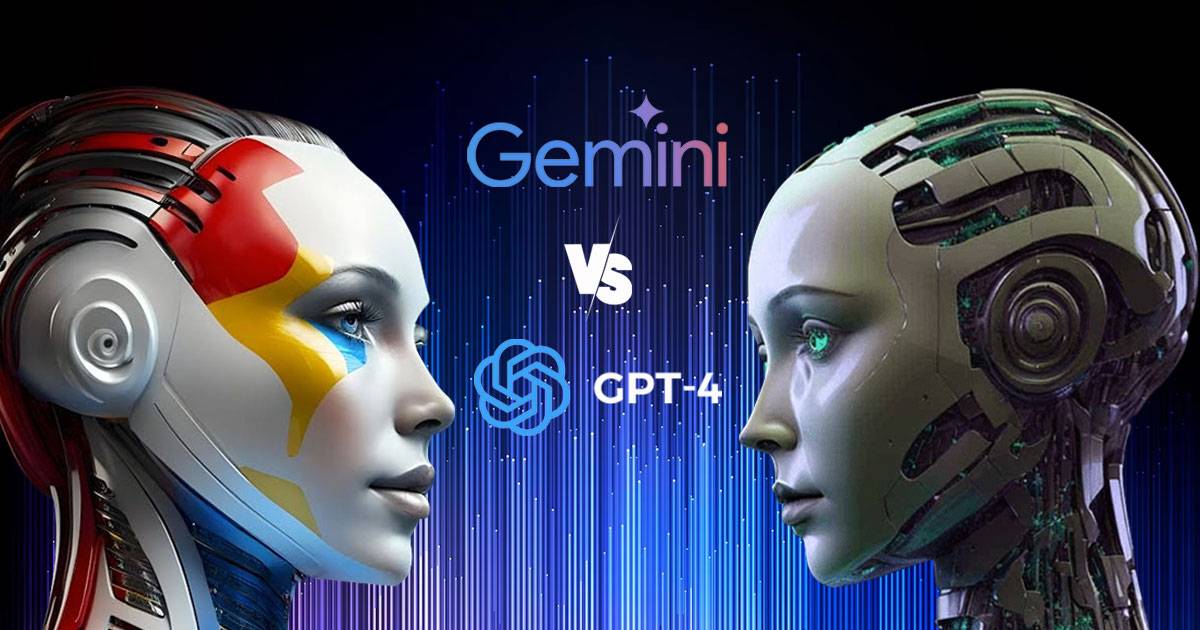Google Gemini or GPT-4: Which AI Reigns Supreme?

Gemini and GPT-4 are two well-known names in the rapidly evolving field of artificial intelligence. Google and OpenAI created these sophisticated language models, which are getting a lot of attention from researchers, developers, and tech fans. As AI keeps growing, it’s essential to know what these models can do and what they can’t.
What is GPT-4?
OpenAI created the advanced natural language processing (NLP) model known as GPT-4, also known as Generative Pre-trained Transformer 4. It builds upon the success of its predecessors, offering improved language understanding and generation capabilities. GPT-4 is designed to generate human-like text based on the input it receives, making it a versatile tool for a wide range of applications, from chatbots to content generation.
What is Gemini?
Gemini, on the other hand, is Google’s latest innovation in the AI space. It is a multi-modal model, meaning it can process and generate text, images, and other types of data. Gemini is designed to understand and develop content across different modalities, allowing for more nuanced and context-aware responses.
Google Gemini vs GPT-4: A Comparison
Here are some critical differences between GPT-4 and Google Gemini:
Language Understanding
- GPT-4 is famous for understanding and creating natural language text. It can understand complex sentences, figure out context, and give clear responses.
- Gemini is also good at understanding language but stands out in understanding how text and images relate, which is excellent for tasks needing knowledge in different ways.
Text Generation
Both GPT-4 and Gemini are good at creating text, but they shine in different areas.
- GPT-4 is great at making long pieces of text, like articles, that make sense and stay relevant. On the other hand,
- Gemini can make text that describes images well, making it perfect for tasks like explaining pictures or telling stories with visuals.
Model Architecture
Both Gemini and GPT-4 use the transformer architecture, which is excellent for natural language tasks. But they are trained differently.
- Gemini, made by Google, likely used Google’s big data and advanced machine learning techniques. This probably helped Gemini become very good at what it does.
- OpenAI trains GPT-4 using a technique known as “constitutional AI,” which aims to instill in the model particular morals and values during training. This could make GPT-4 more responsible, but we’re not sure how much it helps yet.
Applications
- GPT-4 is good for tasks needing deep language understanding, like making content, chatbots, and translating languages.
- Gemini is better for tasks where you need to work with both text and images, like recognizing images, answering questions about visuals, and creating multimedia content.
Interpretation of Text, Images, Videos, Audio, and Code:
- Both Gemini and GPT-4 can interact with and interpret these types of data, making them versatile for various tasks.
Extensions and Augmentations
- Gemini can integrate with Google services like Flights, Hotels, Maps, YouTube, and Workspace applications, expanding its functionality across various Google platforms.
- GPT-4 offers a diverse range of third-party plug-ins, enhancing its capabilities in areas such as shopping, math, app integration, and more. This extensive library of plug-ins allows users to customize GPT-4 to suit their specific needs.
Customization
- GPT-4 allows users to create custom versions tailored to specific tasks, enabling them to focus the model’s capabilities on particular areas of interest or expertise.
- In contrast, Gemini currently lacks customization options, limiting its adaptability to specialized tasks or industries.
Image Generation
- GPT-4 can make pictures by itself using DALL-E 3, which gives it a significant edge in creating images compared to Google Gemini. It can create images from words without needing other tools.
- Gemini, on the other hand, needs help from external tools or models to make images. This means GPT-4 is better for creative tasks that require visual content.
Response Time
- Gemini is known for its quick response times, providing users with rapid feedback and interaction.
- In contrast, GPT-4 may experience slowdowns or interruptions during periods of high usage, which can affect its responsiveness and usability.
Fact-Checking
- GPT-4 provides source links for claims made in its responses, allowing users to verify the information independently.
- Users can use Gemini to conduct a Google search for confirmation, giving them a way to verify the model’s information.
Ethical Considerations and Responsible AI
Both Google and OpenAI care about making AI safe, transparent, and aligned with human values.
- Google follows its AI principles, focusing on privacy, accountability, and avoiding bias.
- OpenAI’s “constitutional AI” for GPT-4 aims to train it to be more ethical and trustworthy.
Price
Both GPT-4 and Google Gemini are available now.
- Gemini Pro is free through Bard with a Google account. GPT-4 is accessible through ChatGPT with a subscription costing $20/month.
- You can also use GPT 3.5 (and sometimes GPT-4) through Microsoft’s Bing Chat. Some tools offer limited free access to GPT-4, but ChatGPT is the main platform.
Challenges and Future Developments
Both Gemini and GPT-4 might have biases and could generate incorrect information, especially when trained on big datasets. Using a lot of computational resources for these models raises questions about their impact on the environment and their scalability. Researchers need to find ways to make them more efficient and sustainable.
Is Gemini better than GPT4?
Gemini and GPT-4 are both advanced AI models with unique strengths. Gemini is good at understanding text and images together, while GPT-4 is known for understanding and generating language well. GPT-4 can be customized for specific tasks, but Gemini responds quickly and works well with Google services. GPT-4 can create images, which Gemini can’t do yet. Both models can be used for fact-checking. The best choice depends on the task at hand, as each model has its advantages.
